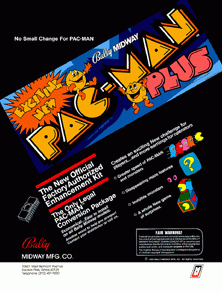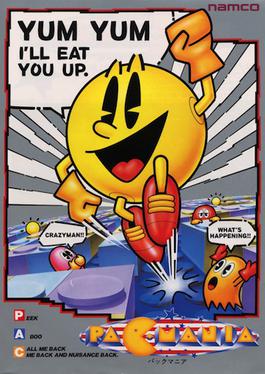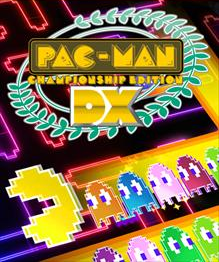
Pac-Man, originally called Puck Man in Japan, is a 1980 maze video game developed and released by Namco for arcades. In North America, the game was released by Midway Manufacturing as part of its licensing agreement with Namco America. The player controls Pac-Man, who must eat all the dots inside an enclosed maze while avoiding four colored ghosts. Eating large flashing dots called "Power Pellets" causes the ghosts to temporarily turn blue, allowing Pac-Man to eat them for bonus points.

Ms. Pac-Man is a 1982 maze arcade video game developed by General Computer Corporation and published by Midway. It is a spin-off sequel to Pac-Man (1980) and the first entry in the series to not be made by Namco. Controlling the title character, Pac-Man's wife, the player is tasked with eating all of the pellets in an enclosed maze while avoiding four colored ghosts. Eating the larger "power pellets" lets the player eat the ghosts, which turn blue and flee.

Pac-Man Plus is an arcade game that was developed by Namco and released by Bally Midway in 1982. It is part of the Pac-Man series of games.

Jr. Pac-Man is an arcade video game developed by General Computer Corporation and released by Bally Midway in 1983. It has the same gameplay as prior entries in the series, but the maze in Jr. Pac-Man scrolls horizontally and has no escape tunnels. The bonus item which moves around the maze changes dots into a form which slows Jr. Pac-Man as they are being eaten.

Super Pac-Man is a 1982 maze chase arcade game developed and published by Namco. It was distributed in North America by Midway, and is Namco's take on a sequel to the original Pac-Man; Midway had previously released Ms. Pac-Man, which Namco had little involvement with. Toru Iwatani returns as designer.

Handheld electronic games are interactive electronic games, often miniaturized versions of video games, that are played on portable handheld devices, known as handheld game consoles, whose controls, display and speakers are all part of a single unit. Rather than a general-purpose screen made up of a grid of small pixels, they usually have custom displays designed to play one game. This simplicity means they can be made as small as a smartwatch, and sometimes are. The visual output of these games can range from a few small light bulbs or LED lights to calculator-like alphanumerical screens; later these were mostly displaced by liquid crystal and vacuum fluorescent display screens with detailed images and in the case of VFD games, color. Handhelds' popularity was at its peak from the late 1970s into the early 1990s before declining. They are the precursors to the handheld game console.

Tinkle Pit is a maze arcade game released by Namco in 1993 only in Japan. It features many of the characters from the company's earlier games.

Pac-Man is a 1982 maze video game developed and published by Atari, Inc. under official license by Namco, and an adaptation of the 1980 arcade game Pac-Man. The player controls the title character, who attempts to consume all of the wafers in a maze while avoiding four ghosts that pursue him. Eating flashing wafers at the corners of the screen causes the ghosts to temporarily turn blue and flee, allowing Pac-Man to eat them for bonus points. Once eaten, a ghost is reduced to a pair of eyes, which return to the center of the maze to be restored.

Snapper is a clone of the Namco arcade game Pac-Man programmed by Jonathan Griffiths for the BBC Micro and released as one of the launch titles for Acornsoft in 1982. It was also one of Acornsoft's launch titles for the Acorn Electron in 1983.

Pac-In-Time is a platform game developed by Atreid Concept featuring the arcade character Pac-Man. It was released in 1995 for MS-DOS, Macintosh, Super Nintendo Entertainment System, and Game Boy.

Pac-Mania is a cavalier perspective maze game that was developed and released by Namco for arcades in 1987. In the game, the player controls Pac-Man as he must eat all of the dots while avoiding the colored ghosts that chase him in the maze. Eating large flashing "Power Pellets" will allow Pac-Man to eat the ghosts for bonus points, which lasts for a short period of time. A new feature to this game allows Pac-Man to jump over the ghosts to evade capture. It is the ninth title in the Pac-Man video game series and was the last one developed for arcades up until the release of Pac-Man Arrangement in 1996. Development was directed by Pac-Man creator Toru Iwatani. It was licensed to Atari Games for release in North America.

Pac-Man Championship Edition is a 2007 maze video game developed and published by Namco Bandai Games for the Xbox 360. It has since appeared on several other platforms, including iOS, Android, and the PlayStation 3 and PlayStation Portable as a PSP mini title available on the PlayStation Store. It is an HD reimagining of the original Pac-Man arcade game; players navigate Pac-Man through an enclosed maze, eating pellets and avoiding four ghosts that pursue him. Clearing an entire side of the maze of dots will cause a fruit item to appear, and eating it will cause a new maze to appear on the opposite side.

Grandstand is a video game console and electronic game manufacturer and distributor. It was based in the United Kingdom and New Zealand and was active in the 1970s and 1980s.

Mini-MunchMan is an LCD handheld electronic game that was released in 1981 in the UK by the manufacturer Grandstand. The game is a rebadged version of the Pac-Man cloneEpoch-Man from Epoch.

Pac-Man Battle Royale is a 2010 maze battle-royale arcade game in the Pac-Man series. Developed and published by Namco Bandai Games, it was made in celebration of Pac-Man's 30th Anniversary. The game sees up to four players control multi-colored Pac-Men as they try to compete to be the last Pac-Man standing.

Jungler is an arcade maze game developed by Konami and released in 1981. Distributed by Stern in the United States beginning in 1982, the game has players controlling a multi-segmented creature attempting to destroy similar enemy creatures by either shooting them or eating them. A sequel titled Battle Jungler was planned for the PC Engine on 1992, but was cancelled.

Pac-Man Championship Edition DX is a 2010 maze video game published by Namco Bandai Games for the Xbox 360 and PlayStation 3, later ported to Steam and iOS. It is the sequel to the 2007 game Pac-Man Championship Edition, which was the last game developed by series creator Toru Iwatani. The player controls Pac-Man as he must eat all of the dots in the maze while avoiding colored ghosts that pursue him. A bonus item will appear once the player has eaten all dots on one side of the maze, causing the layout to change. Several additions were made over the original, such as bombs that send all ghosts to the regeneration box and sleeping ghosts that will give chase when Pac-Man moves past them.

Pac-Man 256 is an endless runner video game developed by Hipster Whale and 3 Sprockets and published by Bandai Namco Entertainment. The game is part of the Pac-Man series and is inspired by the original Pac-Man game's infamous Level 256 glitch, as well as Hipster Whale's own game Crossy Road, which previously featured a Pac-Man mode. The game was originally released as a free-to-play title for iOS and Android on August 20, 2015. In June 21, 2016, Bandai Namco Studios Vancouver released a version of the game for the PlayStation 4, Xbox One, and PC, featuring additional features like multiplayer for up to 4 players, a new power-up, and no longer having to wait a certain amount of time to get power-ups, and instead having to eat a number of Pac-Dots.

Pac-Man 99 was a maze video game with battle royale elements developed by Arika and published by Bandai Namco Entertainment for the Nintendo Switch. It was released through the Nintendo Switch Online service on April 7, 2021.




















